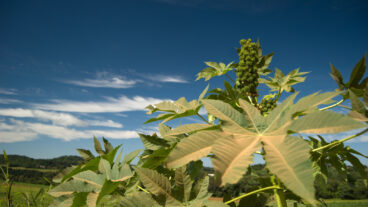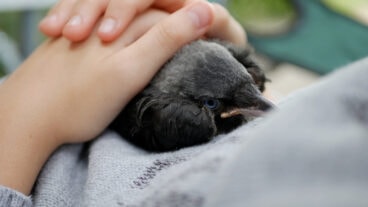Making avocado blossom more attractive to bees is at the root of the Israeli research.
To the many mysteries of love, add avocados.
Scientists have spent decades trying to figure out how avocado trees have sex. A tree can sprout as many as a million blossoms in spring, but only 150 to 500 wi11 bear fruit.
Some avocado flowers bloom as females in the morning, then appear the next afternoon as males. Other avocado species do the opposite.
Honeybees are not impressed. Bees that break-dance with excitement in the hive after discovering a rich source of citrus blossoms do a slow shuffle when bringing news of avocado.
“The joke of nature is that most citrus trees don’t need pollination… and on the other hand, the avocado trees don’t get any fruit without the pollination of the honey bees,” said Ohad Afik, a doctoral candidate at the Hebrew University of Jerusalem’s bee research center.
Others, however, argue that avocados have sex in the wind. Bees aren’t needed, asserts the University of Florida’s Thomas Davenport. He’s done experiments with avocado trees wrapped in bee-proof nets that show lots of pollination occurs when the wind moves pollen from one flower to another.
“A controversial view,” said Mary Lu Arpaia of the botany department at the University of California-Riverside.
Researchers in Rehovot and the University of California at Riverside report “a strong correlation” between bee activity and orchard fruit.
It’s more than academic.
“We average about 7,300 pounds per acre per year in California,” said Guy Witney of the California Avocado Commission. “We should be able to produce about 30,000 pounds per acre.”
It’s an important crop for growers in Mexico, southern California, Israel, Chile, Argentina and South Africa. Mexico is far and away the largest producer, with annual harvests of more than 2 billion pounds.
Avocados – whether in salads, soups or guacamole – are gracing more tables across America. Annual consumption has more than doubled in the last six years, to an estimated 980 million pounds, according to the California Avocado Commission. Americans ate 47 million pounds of avocados on Cinco de Mayo.
So, if avocados are so popular with the human palate, what’s with the bees?
A team of Israelis – led by Hebrew University entomologist Sharoni Shafir, horticulturalist Amon Dag of the Ministry of Agriculture and Afik – is trying to find out.
The Israeli scientists work in honeycomb-shaped offices surrounded by dozens of hives and more than a million bees. Here they artificially inseminate queen bees, run chemical analyses of honey strains, count pollen grains and film bees caught by the head and shoulders in a 24-hole plate as they extend their tongues to a puff of fragrance or a pipette of nectar.
Bees and avocados are not natural partners. Avocados are native to Central America. Christopher Columbus brought the first bees to the Western Hemisphere, said entomologist Sharoni Shafir.
Another clue to the avocado mystery sits on an end able of Shafir’s lab. He offers a tiny spoon and two goblets of honey – one dark and fluid, the other golden and thick. Bees make the darker honey from avocado nectar. The golden, sweeter honey comes from grapefruit nectar.
“The avocado honey is good for cooking, but a bit bitter,” Shafir said. “And it’s extremely rich in minerals.”
Growers bring beehives to their orchards to move pollen from one flower to another, but it’s an easily distracted workforce. The most common type of honeybee, the Italian, would rather spend a sunny morning flitting among orange blossoms or wildflowers.
“They’ll go to avocado, but if a citrus tree is blooming nearby, bees will make a bee line to citrus and not to avocado,” Arpaia said.
A grower in southern California who used Austrian honeybees (New World Carniolans) saw more of them lingering in the avocado orchard than rushing off to another flower, and a hypothesis was born.
Tests were conducted between 1999 and 2001 in both Israel and southern California in a joint study to see if Austrian honeybees are better for avocado romance than the more common Italian. That might indicate a possible genetic preference for avocado nectar – and a boon for avocado growers seeking a Viagra-like boost for crop yields.
With direct observation of every bee dizzyingly impossible, how do you know if bees linger amid the avocados? The answer is in the honey.
Arpaia demonstrated in the 1990s that avocados produce a unique sugar called perseitol. Measuring the concentration of perseitol in a hive’s honeycombs showed the Austrians made better lovers.
But even after proving that Austrian bees are better for avocado pollination than Italians, the Israeli scientists wanted to know why both types of bees would, all things considered, rather be with an orange.
Dag, Shafir and Afik did a series of experiments. Bees were caught leaving the hives in the morning in glass vials and put on ice for one to two minutes. The chilled bees were strapped into plastic tubes using tiny strands of duct tape, and inserted into the holes of a revolving plate. Each bee then got a whiff of eugenol and a taste of sugar water, citrus honey or avocado honey.
The bees liked the citrus honey best, and soon came to associate the odor with citrus nectar. Other experiments with outdoor feeders showed 11 of 12 colonies preferred citrus over avocado.
What seems to discourage the bees is the mineral composition of avocado nectar. Afik found high concentrations of minerals, particularly potassium and phosphorus, in avocado honey. You might guess this is related to fertilizers, but horticulturalist Amon Dag tested for that.
What’s next?
Shafir says their experiments show that bees can be bred to develop a taste for avocado, but it will be up to someone in the avocado business to do that work.
“Until today, there is no commercial bee line for pollination,” he said.
So your average avocado tree will just have to get by with a sex life that’s either on the whim of a bee or blowing in the wind.
(Originally appeared in the Dallas Morning Herald)












